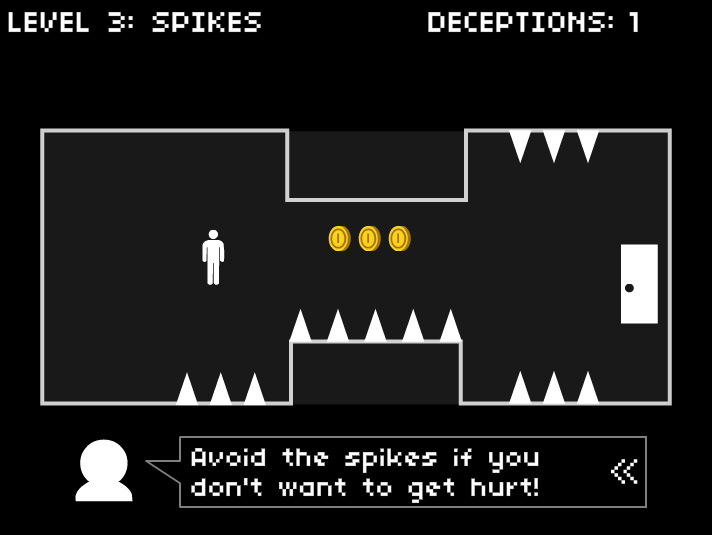Wellcome Trust ExPlay Game Jam Shortlist Announced!
/On the 5th and 6th of October this year we held the Wellcome Trust ExPlay Game Jam (also see here). This event, over two locations, the Science Museum in London and the Pervasive Media Studio in Bristol, saw over 100 developers create 22 games around the theme of Deception. The theme was presented to the group by Professor Bruce Hood. The judging panel, Professor Hood, John Williams - Head of Neuroscience and Mental Health at the Wellcome Trust and Dan Effingham - Creative Director at Aardman Digital, reviewed the games, and eight out of 22 were then shortlisted to be shown at the ExPlay Festival on the 2nd November. Prize-winners will also be announced at the event for first and second place and a Wildcard place too. The judging was based around the balance of the gameplay and the science so the judges looked for great games that integrated the science into the gameplay. The games needed to be fun to play; they were not looking to develop a 'worthy' game, it needed to be fun in its own right. The aim was to make the combination of the science and the gameplay engage the player; those that did scored well.
The shortlisted games (in no particular order) are:
Alien Laser Bunnies (Unity download) - video link A two-player game about hiding within the crowd. Players must figure out which of the identical bunnies is them, then collect objects and use their laser to kill the other player before they can do the same. The movement of the other bunnies is based on an algorithm that records the movements of the players and re-uses them for movement of AI controlled bunnies. The developers wrote of their game; “Winning at Alien Laser Bunnies requires people to exercise social mimicry. They must imitate the movements of previous players in order to best deceive their opponent. In this respect it provides a strong framework for various tactics of deception. Further, the game tends towards a state of homeostasis as the mimicry creates a feedback loop of behaviours.”

Qualit-eye Control (iPad) - video link Based around the structure of the human eye and using the inspiration of the Thatcher Illusion, where it becomes hard to detect changes in an upside-down face. In this puzzle game, the player must select if a given object is really the same as its mirrored counterpart. The developers wrote of their game; “Given the theme of deception in science, we began thinking about how the human eye is an astoundingly amazing tool - yet deceptive. The human brain has to process a lot of data continually, so will occasionally make assumptions and take shortcuts, meaning we occasionally interpret false images in line with our expectations… So we developed Qualiteye Control, a game that puts the player in the position of a miniature scientist acting as a controller between the eyeball and the brain of Prototype X1.”

InCogNeto (Android download) A two-player game in which each player must connect cogs to a top wheel and at each turn select it to mask their actions or advance their plans. The developer wrote of their game, "...inspired by the idea of subterfuge, how we deceive ourselves and create false realities when we don’t have all the information... Strategy and tactics play an important role as you read your opponent’s body language, listen for audible clues (i.e. the rack moving) and use spatial memory to spot changes in the playspace. While your body is performing quality control of a widgetoid factory - you must decide what widgetoids are correct, and which ones are being falsely interpreted and need to be rejected quickly."

HIVe (Java download) - video link In HIVe the deception moves to a molecular level, where one player is a HIV infected cell disguised as a normal cell, seeking to infect other cells. The second player is an antiretroviral seeking to find and destroy the infection. The developers write, “The objective of the HIV player is to infect as many cells as possible before being caught by the antiretroviral drug player. We felt that the lifecycle of a virus is a constant battle of deception with the body and our game tries to capture this whilst at heart still being a game and being fun. We felt using HIV as the virus was important for its relation to scientific research and global social issues.”

DupliCity (Unity download) - video link This action game sees the player running along trying to avoid objects, but with a twist, as the game itself sets out to confuse and deceive. The developer states: “You and your shadow run simultaneously in mirror worlds populated by obstacles. Why? To escape. Also because there's fireworks at the end! Through the use of asymmetry, transparency, repetition and subliminal signs, the game helps you overcome the obstacles but also misleads you. A briefly flashing arrow directing you; a sign on a truck; a crate that looks real but isn't - things that you notice and take for granted even if you aren't paying attention.”

Doors of Deception (Flash download) In this game we have to ask ourselves to question the truth of what the game is telling us. Can the game deceive us more that we can progress? The game is a five level puzzle game of truth, lies, deception, illusions and more. You can only progress if you figure out how to solve the puzzles in spite of the seemingly helpful narrator.

The Art of Deceit (Web-Comic) - video link A web-comic about deception, the developers write, “The Art of Deceit is an interactive science fiction comic for children that explores the role of falsehood and misinformation in the intelligence services. Set on a distant asteroid, the player takes on the role of a spy with a vital top secret mission... Success is dictated by the player’s ability to correctly spot and interpret optical illusions. As a whole the game highlights that visual perception cannot always be trusted. The components of an object can distort the perception of the complete object. Our mind is the final arbiter of truth.”

Blood Stream Bandits (Android download) - video link In this action game, we again return to the molecular level, “Working together with a neurobiologist, we came up with a game inspired by viruses that enter the bloodstream and deceive body defences by pretending to be harmless cells. In our game you control triangular shapes, which can be combined to form squares. There are two types of monsters, one eats triangles and the other eats squares, and each can be deceived by arranging your units in the corresponding opposite shape. The game requires reflexes and quick thinking to arrange your units to deceive as many enemy cells as you can.”

Remember, each of these games had a maximum of 24 hours of development and given many teams elected to catch a few hours sleep, most of them had less. So a huge well done to all the teams who competed, not just those shortlisted; the judges had a tough time with their selections!

